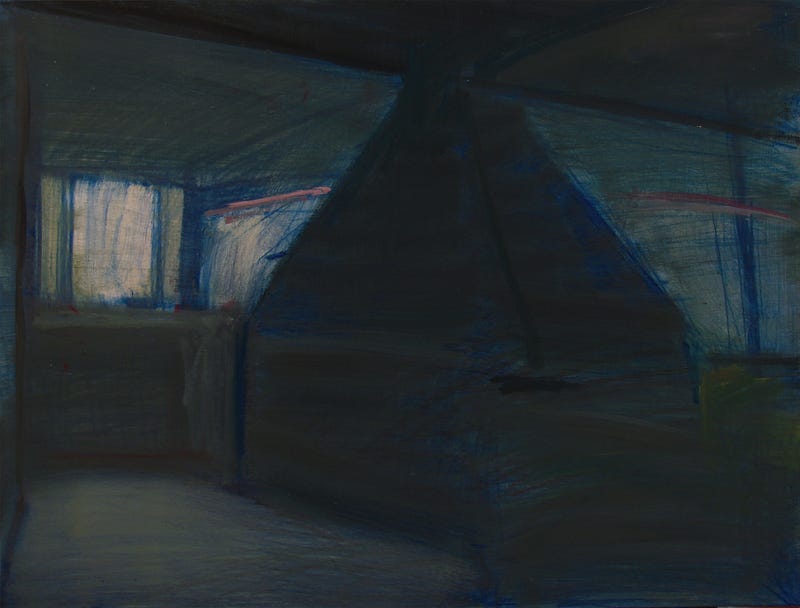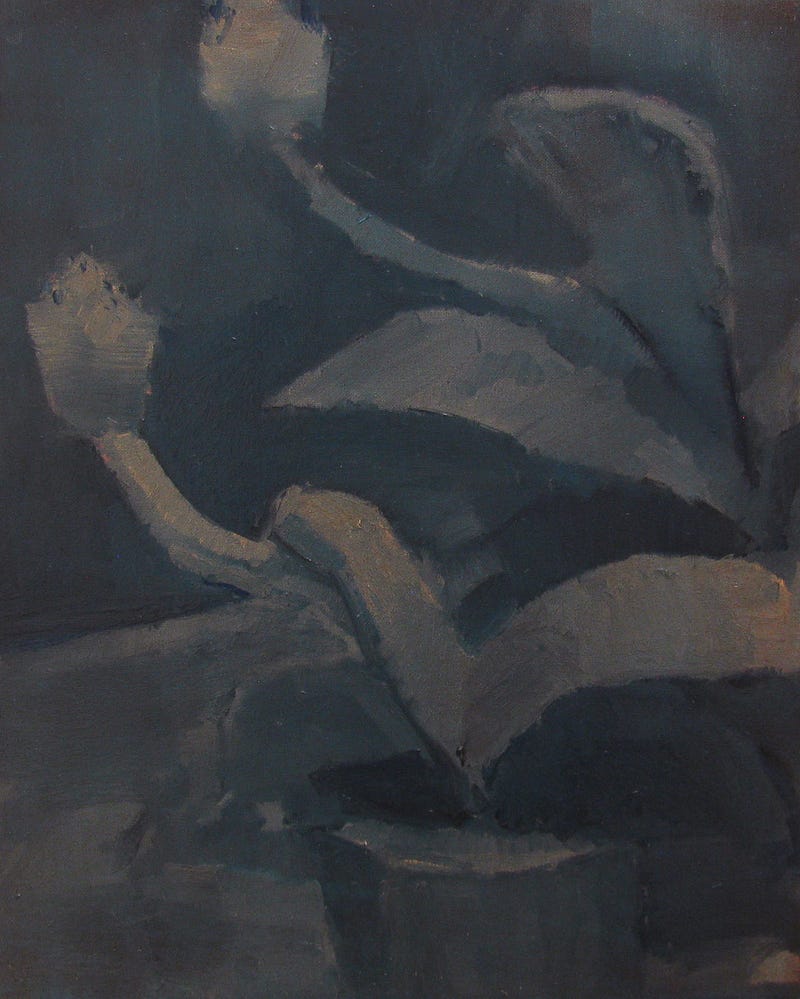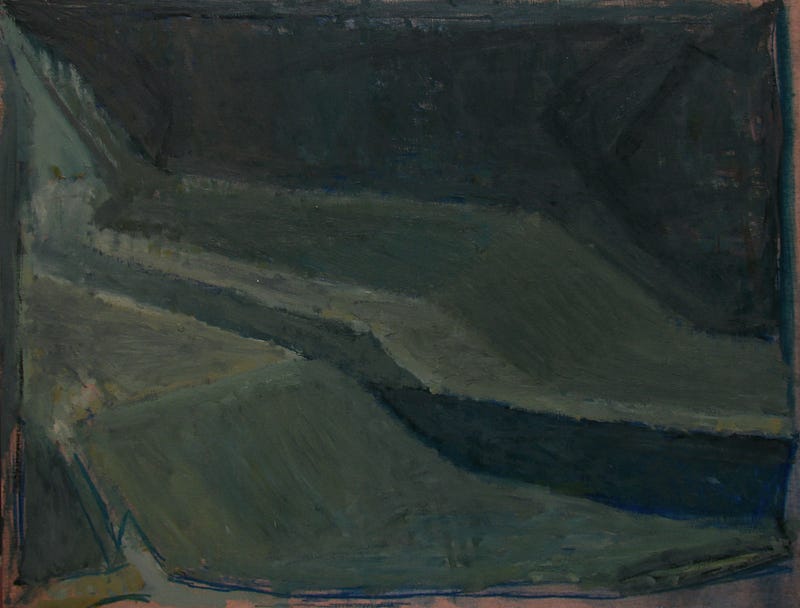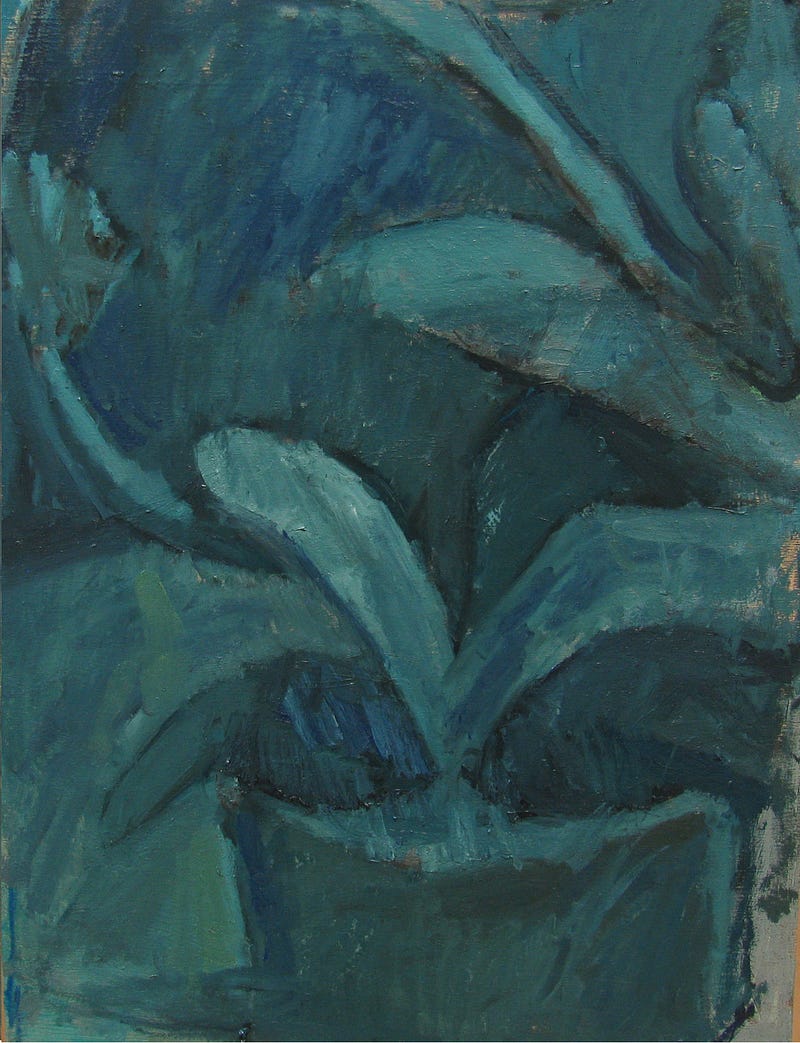28.02.2023
Andreas Ragnar Kassapis: Monitors of Intuition
Visual arts
Andreas Ragnar Kassapis can be found working in an apartment, a former architect’s office in a residential area, in the environs of central Athens. “We live in the city. We live in the block of flats. We see the block of flats as a cave”¹ he wrote in the accompanying text of his solo show in Kalfayan Galleries in 2021. His studio is a cave itself, encapsulated in a block of flats, distanced from the vivid core of the Athenian artworld, yet close to it in terms of practicality. One can work there undistracted. Afar but approachable. Among family houses, other professionals, shop owners, families, students, Kassapis is painting, drawing, writing, composing and playing music in working-hour shifts.

This multitasking, however, in the case of Kassapis seems to be employed in favor of painting. His texts are notes of his painstaking observation of the most delicate and indiscernible functions of human memory and perception. Poetic landscapes of self-reflection that stand as pieces of literature per se, his texts are compositions of scattered diary excerpts that the artist puts together in order to organize his research on image making. “Look at these plants below. How does it sound like?”² Kassapis writes, and even though he — proudly — admits this question was initially posed by his 3-year-old son at the time, one can’t help but, read it in relation with his own preoccupation with sound making. His soundscapes, distant analogue tones, are made to be listened to in his own studio during the actual process of painting. An analogue audio mixer, an old phone (a few devices he displayed in his last solo show “Pliance” in Radio Athènes, Athens in December 2022 as a sound installation from his soundscape series “Rooms in Negative”) are always in the room, placed beside him, actively involved in the creative process. Even though it is certain that artists rarely produce the soundtrack that accompanies their studio work, Kassapis speaks of this particular practice in a casual and humble way, as if his sound pieces are necessary painting tools, practical devices that are just “part of the job”.

I notice that, in contrast with his paintings, his soundscapes emerge from the outside, open-air, sometimes natural, physical spaces. In the calm and introverted capsule of the studio, they infuse instances of what is — or could be — taking place within the infinite dimensions of the exterior environment. This carefully premeditated condition that prevails over the apartment that is the artist’s studio, what purpose does it serve? What’s the use of this perfectly curated set-up: the soundwaves vibing through the speakers, the clear-cut lighting, the relics of the former architectural office, instruments of the design discipline, wooden rulers, the old tv and the slide projector, vintage design magazines, notebooks and markers, the brushes and papers, personal objects.
Trying to comprehend how the manipulation of the surroundings of the creation affects the work, I asked him about its relationship with space, yet our conversation would always lead us to the concept of time. Kassapis’ painting is a long study on memory, specifically in the very process of recollection. His works lie precisely on this conjunction of time and space, where subjectiveness, intuition, perception and human body coproduce an attenuated reflection of the lived experience. Series of paintings that formalistically consist of compositions of objects and landscapes unfold aspects of what the artist refers to as the “nuance of memory”: the distortions, the superpositions and the deductions that formulate an image within the mechanism of recollection, a process affiliated, according to him, to the concepts of repetition, duration and mood³. His paintings, parts of indivisible series, are often seen as studies of color and shape on a subject, a perception he welcomes from the position of a painting and drawing teacher, a parallel profession he devotes himself to this day. After all, how can one study perception, if not by assimilating it from the subjective gaze of the other?

And then again, we return to the concept of duration. As the viewer spends more time gazing on Kassapis’ series of paintings, they realize that the matter of composition and technique is not his main concern, even though it remains his credible vehicle. Within their absolute silence, his canvases disclose a sequence, a rhythm which — as obscure as it may be — certainly remains present. Slight changes on the dubious position of the potential light source and on the overall framing of the subject suggest the existence of a microscopic movement that entangles among the pieces that form the series. This type of motion is so vague, one might question their own vision, or even, the artist’s intention. Is it there? Is it actually taking place or it is us, the viewers who fail to recall the details, as our sight moves across the painting surfaces?
That sense of mistaking that to the artist resembles a Freudian slip, engages the viewer with his eternal subject: the autonomous life of human memory. That familiar sense of intuition that renders us at the disposal of the empirical object, the esoteric state of being present in several timelines, our unique way to recall an image . With this theoretical diagonal in mind, that I think strikes through his work, I personally tend to see Kassapis’ painting series, as a juxtaposition of analogue monitors, continually projecting impressions of objects, bodies and spaces that I have actually encountered at some point. “These photos I collect, I do not distinguish them from my personal ones. They are not photos of facts, but they help to recollect”⁴ he writes.

Merging into his work, I feel I can relate more to the instrumented atmosphere of his studio and the practice that is taking place there. I like to think that Kassapis is creating a simulation, a space where himself -if exhaustively focused- can capture the material traces of memory. With the soundscapes insulating every corner of its shell, the charged and stimulating objects, its dense quietness, the artist’s studio is a space where he observes the experience of recollection, he runs trials and experiments and records fragments of this intimate and abstruse mental process. The journal of this investigation is transcribed in his canvases, captured in his sound pieces, spoken in his writing.
Andreas Ragnar Kassapis (b. 1981) studied at the School of Fine Arts in Athens from 1999–2004 where he lives and works. His work includes painting, drawing, photography, text, sound and music. He has also worked on set designs and as a teacher. Solo shows: Pliancy (Radio Athenes,2022.Athens. The Shallow Room (A Sud, Pescara 2022). To see a block of flats as a cave (Kalfayan galleries,Athens, 2021).’Melting snow as if in a room’, Andreas Ragnar Kassapis / Konstantinos Hadjinikolaou (Tavros, Athens, 2021), ‘Songs’. Athanasios Argianas / Andreas Ragnar Kassapis (Hero Gallery, Amsterdam, 2018), ‘Breakwater’ (Independent Space, Athens 2015), ‘How Can one Remember Thirst?’ (Loraini Alimantiri
Gallery, Athens 2011), ‘Bones are Tight’ (Loraini Alimantiri Gallery, Athens 2008), ‘Numb’ (Loraini Alimantiri Gallery, Athens2006).Selected group shows: Documenta 14 (Art Director: Adam Szymczyck, Cur. Katerina Tselou, Athens / Kassel 2017), ‘Reverb: new art from Greece’ (cur. Evita Tsokanta — Eirine Efstathiou, Boston, 2014), ‘Hell as Pavillion’ (cur. Nadia Argyropoulou, Palais de Tokyo, Paris, 2013), ‘Heaven’, Athens Biennale (cur. Christoforos Marinos, Athens, 2009), ‘Anathena’ (cur. Marina Fokidi-Marina Gioti, Athens, 2006). Selected set designs: ‘Era Povera’, Patricia Apergi (Athens 2012), ‘As my Heart in a Storm’, (Bijoux de Kant, Athens, 2012). ‘Blossom’, Agni Papadeli Rossetou. Selected music works:Rooms in negative-Lucky Boys published on tape.(untitled. 1) 2019. Rooms in Negative, published on vinyl (2009), Look and the Beast, Music for the dance performance by Agni Papadeli Rossetou. Andreas Ragnar Kassapis was awarded the Stavros Niarchos Foundation (SNF) Artist Fellowship by ARTWORKS in 2020.
Christina Petkopoulou, (Athens, 1992) is a free-lance curator, researcher and writer based in Athens. She has studied Archaeology and History of Art at the National and Kapodistrian University of Athens and the Paris I-Pantheon-Sorbonne and completed a master’s degree in Cultural Management at the Panteion University of Social Sciences. She is a member and the in-house curator of the A-DASH team, a researcher and curator of the online art projects a time of her own by Zoe Chatziyannaki and Athens Report by Anna Lascari. She has curated exhibitions and public programs (Lipiu, 2020, Playing Ground, Automatic Transmission, 2019, Liminal Aristeidis Lappas solo show, Praxitelous 33, 2016, Choro-graphies-Points of flight, Artscape Athens, 2014 and more). Her texts have been published in several editions and catalogues (The ArtNewspaper Greece, Lipiu, Vera Chotzoglou, Bona Fide, State of Concept, 2021, Ammophila II, Under the Burning Sun, 2021, The Feminine Sublime, 2019 and more). She has worked for the Greek Contemporary Art Institute (ISET) researching and documenting its archive and she has also collaborated with several cultural institutions such as the Athens Biennale (2013, 2015), Art Athina (2014, 2015) and Archaeological Dialogues (2015). In 2016, she was chosen for the Neon Foundation curatorial exchange program in collaboration with the Whitechapel Gallery and in 2019, she received the SNF Artist Fellowship by ARTWORKS. She also works as a teacher and a copy editor.
¹ Andreas Ragnar Kassapis, 2021, To see a block of flats as a cave, translated from Greek by Michalis Varouxakis
² Andreas Ragnar Kassapis, 2022, Pliancy, translated from Greek by Michalis Varouxakis
³ In Bergson found as “la durée” and “stimmung”
⁴Andreas Ragnar Kassapis, 2022, Pliancy, translated from Greek by Michalis Varouxakis



